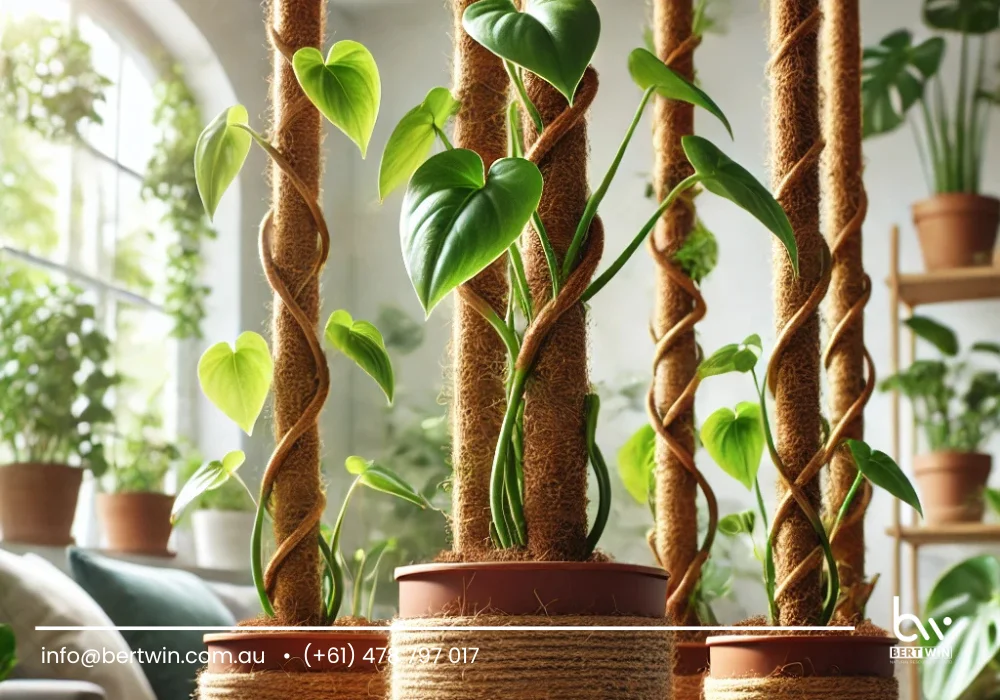Coco coir moss pole is an essential tool for plant enthusiasts looking to support their climbing plants effectively. These poles, made from natural coconut fibers, offer numerous benefits that enhance plant growth and health. In this article, we will explore the advantages of using coco coir moss poles, how they work, and why they are becoming increasingly popular among indoor gardeners.

The Benefits of Coco Coir Moss Poles
Coco coir moss poles provide a variety of benefits that make them an excellent choice for supporting climbing plants. One of the primary advantages is their ability to mimic the natural environment of tropical plants. In nature, many climbing plants grow up trees and other structures, allowing them to reach sunlight and thrive. By using coco coir moss poles, you can replicate this environment, encouraging your plants to grow taller and healthier.Additionally, coco coir is known for its moisture-retentive properties. When you mist or water the pole, it retains moisture that can be accessed by the plant’s aerial roots. This hydration is crucial for the growth of epiphytic plants, which rely on moisture from their surroundings to thrive. Regular maintenance of the pole ensures that your plants receive the necessary hydration without the risk of overwatering the soil.Another significant advantage of coco coir moss poles is their durability. Unlike traditional moss poles that may decompose over time, coco coir is resistant to breakdown and can last for several growing seasons. This longevity makes them a cost-effective solution for plant support, as you won’t need to replace them frequently.
How to Use Coco Coir Moss Poles Effectively
To maximize the benefits of coco coir moss poles, it’s essential to use them correctly. Start by selecting a pole that suits your plant’s size and growth habits. For larger plants like Monstera or Philodendron, choose a taller pole to accommodate their growth potential. Once you have your pole, insert it into the pot alongside your plant, ensuring it is securely anchored in the soil.As your plant grows, gently guide its stems towards the coco coir moss pole. You can use soft ties or clips to attach the stems to the pole if necessary. This support encourages vertical growth and allows the plant to develop larger leaves and more prominent fenestrations.Regularly misting or watering the coco coir pole is crucial for maintaining moisture levels. Aim to keep the pole damp but not soggy; this balance will provide your plant with adequate hydration while preventing root rot. Additionally, placing your plants in a well-lit area will help them thrive as they climb towards the light.

Why Choose Coco Coir Over Other Materials?
When considering plant support options, many gardeners may wonder whether to use coco coir or traditional moss poles. While both materials have their merits, coco coir offers unique advantages that make it a preferred choice for many indoor gardeners.First and foremost, coco coir is eco-friendly and sustainable. As a byproduct of coconut processing, it provides an environmentally responsible option compared to synthetic materials. This sustainability aspect appeals to environmentally conscious consumers who want to reduce their ecological footprint while caring for their plants.Moreover, coco coir moss poles are easier to maintain than traditional moss poles. They do not require frequent replacement due to their durability and resistance to degradation. This quality not only saves time but also reduces waste in gardening practices.Lastly, coco coir’s fibrous texture allows for excellent aeration and root attachment. The aerial roots of climbing plants can easily grip onto the rough surface of the coir pole, promoting healthy growth and stability as they ascend.
FAQs About Coco Coir Moss Poles
1. What types of plants benefit from using a coco coir moss pole?
Coco coir moss poles are ideal for epiphytic plants such as Monstera, Philodendron, Pothos, and climbing orchids. These plants naturally grow upwards in their native habitats and benefit significantly from vertical support.
2. How often should I water my coco coir moss pole?
It’s best to mist or water your coco coir moss pole regularly—approximately once a week or when you notice it starting to dry out. The goal is to keep it damp but not soggy to prevent mold growth or root rot.
3. Can I use a coco coir moss pole outdoors?
Yes! Coco coir moss poles can be used outdoors as long as they are placed in a sheltered location that protects them from extreme weather conditions. Ensure they are adequately watered during hot weather.
4. How do I clean my coco coir moss pole?
To clean your coco coir moss pole, gently wipe it with a damp cloth or sponge if there’s any dust buildup. Avoid using harsh chemicals; instead, stick with mild soap and water if necessary.
5. How long do coco coir moss poles last?
Coco coir moss poles can last several growing seasons when properly maintained. Their durability makes them a cost-effective choice compared to traditional moss poles that may decompose more quickly.In conclusion, incorporating a coco coir moss pole into your indoor gardening routine can significantly enhance your plants’ growth and health. With their ability to replicate natural climbing conditions, retain moisture effectively, and provide long-lasting support, these poles are an invaluable asset for any plant lover. Whether you are nurturing small vining plants or larger tropical species, a coco coir moss pole can help you cultivate a thriving indoor garden environment.By understanding how to use coco coir moss poles effectively and recognizing their benefits over other materials, you can ensure that your climbing plants reach their full potential while enjoying a sustainable gardening practice.
For further information, you may contact WhatsApp at (+62) 812-1233-3590 or via email at sales@arlion.co.id.
